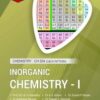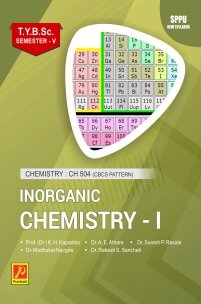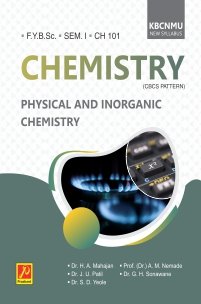CH-504 | Inorganic Chemistry - I
T.Y.B.Sc. | Sem V | Chemistry
Authors:
ISBN:
₹130.00
- DESCRIPTION
- INDEX
T.Y.B.Sc. | Sem V | CH-504
CHEMISTRY
Inorganic Chemistry – I
It’s a great pleasure for us to present this book Inorganic Chemistry-I (CH 504, Semester V) for T.Y.B.Sc. Physics students of the Savitribai Phule Pune University, Pune. This book is written as per the revised syllabus of Savitribai Phule Pune University, Pune to be implemented from June 2021.
We have tried to explain the concepts & information in lucid language so that students could understand it easily. Many senior faculty members have inspired us to perform this duty. We feel it’s not a new creations but presentation in simple form for the better understanding of students.
1. Molecular Orbital Theory of Coordination Compounds
1.1 Electro-neutrality principle
1.2 Multiple bonding (dπ-pπ and dπ-dπ)
1.3 Nephelauxetic effect and Nephelauxetic series (Recapulation from VBT and CFT),
1.4 Need and introduction of MOT
1.5 Assumptions of Molecular orbital theory,
1.6 MO treatment to octahedral complexes with sigma bonding, Formation of MO’s from metal orbitals and Composite Ligand Orbitals (CLO),
1.7 MO correlation diagram for octahedral complexes with sigma bonding,
1.8 Effect of π bonding on MO correlation diagram,
1.9 Charge transfer spectra,
1.10 Advantages of MOT over VBT and CFT.
Exercise
2. Inorganic Reaction Mechanism
2.1 Introduction
2.2 Basic concepts of stability and lability
2.3 Stability constants
2.4 Factors affecting lability
2.5 Chelate effect
2.6 Classification of inorganic reactions
2.7 Ligand substitution reactions
2.8 Substitution Reactions in Four Coordinated square planar complexes
2.9 Trans effect and Trans effect series
2.10 Applications of trans effect
2.11 Stereochemistry of substitution reactions
Exercise
3. Chemistry of Transition Elements
3.1 Introduction
3.2 Position in the Periodic Table
3.3 Electronic Configuration
3.4 Trends in the Properties of d-Block Elements
3.4.1 Size of Atoms and ions, 3.4.2 Reactivity, 3.4.3 Catalytic Activity, 3.4.4 Oxidation State, 3.4.5 Complex Formation Ability, 3.4.6 Colour, 3.4.7 Magnetic Properties, 3.4.8 Non-stoichiometry, 3.4.9 Density, Melting Point and Boiling Points.
Exercise
4. Chemistry of F-Block Elements
Introduction of f-block elements – on the basis of electronic configurations, occurrence and reactivity.
4.1 I. Lanthanides : 4.1.1 Position in periodic table, 4.1.2 Name and electronic configuration of lanthanides, 4.1.3 Oxidation States, 4.1.4 atomic and ionic radii, 4.1.5 Lanthanide contraction, its causes and consequences on chemistry of Lanthanides and post lanthanide elements, 4.1.6 Occurrence and separation : Bulk separation, Individual separation by modern methods viz., Ion exchange and solvent extraction method, 4.1.7 Applications of lanthanides.
4.2 II. Actinides : 4.2.1 Position in periodic table, 4.2.2 Names and their electronic configurations. 4.2.3 IUPAC nomenclature system for super heavy elements, 4.2.4 Oxidation States, 4.2.5 Occurrence and general methods of preparation of transuranic elements Neutron Bombardment, Accelerated projectile bombardment, Heavy ion bombardment. 4.2.6 Nuclear Fuels, Nuclear fission Fuel, Nuclear fusion fuels. 4.2.7 Comparison between Lanthanides and Actinides
Exercise
5. Metals, Semiconductors and Superconductors
5.1 Introduction
5.2 Metallic bonding
5.3 Band theory in metals with respect to Na along with n (E) and N(E) diagrams
5.4 Electrical conductivity of metals (Na, Mg, Al)
5.5 Valence electrons and conductivity of metals
5.6 Effect of temperature and impurity on electrical conductivity of metals
5.7 Semiconductors, Types of Semiconductors : I. Intrinsic Semiconductors, II. Extrinsic Semiconductors,
5.8 Effect of temperature and impurity on semiconductivity,
5.9 n- type and p-type semiconductors
5.10 ZnO and NiO,
5.11 Superconductivity : Discovery, Property, Models, Structure and superconductivity, Low and high temperature superconductors,
5.12 Applications of superconductors.
Exercise






